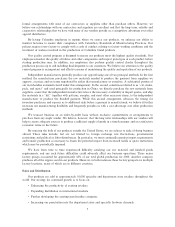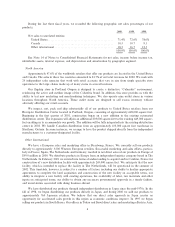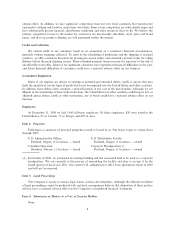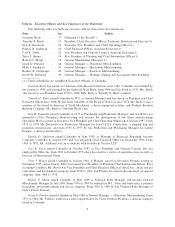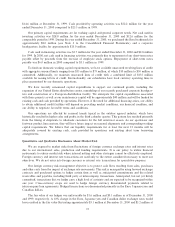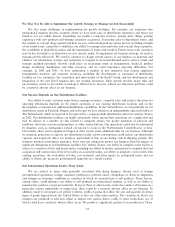Columbia Sportswear 2000 Annual Report Download - page 27
Download and view the complete annual report
Please find page 27 of the 2000 Columbia Sportswear annual report below. You can navigate through the pages in the report by either clicking on the pages listed below, or by using the keyword search tool below to find specific information within the annual report.$14.6 million at December 31, 1999. Cash provided by operating activities was $52.2 million for the year
ended December 31, 2000 compared to $23.5 million in 1999.
Our primary capital requirements are for working capital and general corporate needs. Net cash used in
investing activities was $28.8 million for the year ended December 31, 2000 and $12.6 million for the
comparable period in 1999. During the year ended December 31, 2000, we purchased the Sorel trademark for
approximately $8.0 million (see Note 2 to the Consolidated Financial Statements) and a corporate
headquarters facility for approximately $13.0 million.
Cash used in Ñnancing activities was $1.7 million for the year ended December 31, 2000 and $2.8 million
for 1999. In 2000, net cash used in Ñnancing activities was primarily due to repayment of our short-term notes
payable oÅset by proceeds from the exercise of employee stock options. Repayment of short-term notes
payable was $6.0 million in 2000 compared to $3.1 million in 1999.
To fund our domestic working capital requirements, we have available unsecured revolving lines of credit
with aggregate seasonal limits ranging from $35 million to $75 million, of which $10 million to $50 million is
committed. Additionally, we maintain unsecured lines of credit with a combined limit of $135 million
available for issuing letters of credit. Internationally, our subsidiaries have local currency operating lines in
place guaranteed by our domestic operations.
We have recently announced capital expenditures to support our continued growth, including the
expansion of our United States distribution center, remodeling of our recently purchased corporate headquar-
ters and construction of a European distribution facility. We anticipate the capital expenditures associated
with these projects as well as our maintenance capital will be approximately $40 million and will be funded by
existing cash and cash provided by operations. However, if the need for additional Ñnancing arises, our ability
to obtain additional credit facilities will depend on prevailing market conditions, our Ñnancial condition, and
our ability to negotiate favorable terms and conditions.
Our operations are aÅected by seasonal trends typical in the outdoor apparel industry, which have
historically resulted in higher sales and proÑts in the third calendar quarter. This pattern has resulted primarily
from the timing of shipments to wholesale customers for the fall outerwear season. As our sportswear and
footwear product lines mature, they will have future impact on seasonal shipments and corresponding working
capital requirements. We believe that our liquidity requirements for at least the next 12 months will be
adequately covered by existing cash, cash provided by operations and existing short term borrowing
arrangements.
Quantitative and Qualitative Disclosures About Market Risk
We are exposed to market risks from Öuctuations of foreign currency exchange rates and interest rates
due to our international sales, production and funding requirements. It is our policy to utilize Ñnancial
instruments to reduce market risk where internal netting and other strategies cannot be eÅectively employed.
Foreign currency and interest rate transactions are used only to the extent considered necessary to meet our
objectives. We do not enter into foreign currency or interest rate transactions for speculative purposes.
Our foreign currency risk management objective is to protect cash Öows resulting from sales, purchases
and other costs from the impact of exchange rate movements. This risk is managed by using forward exchange
contracts and purchased options to hedge certain Ñrm as well as anticipated commitments and the related
receivables and payables, including third party or intercompany transactions. Anticipated, but not yet Ñrmly
committed, transactions that we hedge carry a high level of certainty and are expected to be recognized within
one year. Cross-currency swaps are used to hedge foreign currency denominated payments related to
intercompany loan agreements. Hedged transactions are denominated primarily in the Euro, Japanese yen and
Canadian dollars.
The fair value of our hedges was unfavorable by $1.6 million and $0.1 million as of December 31, 2000
and 1999, respectively. A 10% change in the Euro, Japanese yen and Canadian dollar exchange rates would
have resulted in the fair value Öuctuating approximately $5.1 million at December 31, 2000 and $3.2 million at
15


